How many times can Spurs turn in a match that, in the moment, seems to embody the progress they’ve made this season?
Monday’s 4-0 win over Stoke City contained a little bit of everything. There was the vibrant full-back play, the efficient midfield press, the impressive accuracy of Harry Kane and – perhaps most importantly – the formidable adaptability of Mauricio Pochettino’s system.
In terms of personnel, this Spurs squad was exactly the same that beat Manchester United 3-0 last weekend. In practice, though, the style was a noticeable shift. Whereas United’s mobile defenders made it difficult for Spurs to break the offside trap, Stoke’s combination of high line and low speed only encouraged the attack to guile their way toward goal.
A good deal of Spurs’ chances – including Dele Alli’s first and Kane’s second – were the result of forcing 2-on-2 or 3-on-2 situations with Stoke’s relatively plodding backline. Mark Hughes’ insistence on pushing up the pitch after Kane’s opener made this much easier on Spurs, who also managed to hit the post twice in additional to their formidable goal haul.
More from Hotspur HQ
- Storybook ending after difficult period for Tottenahm’s Richarlison
- Tottenham comeback showcased invaluable intangible Ange has cultivated
- Tottenham player ratings in 2-1 comeback win over Sheffield United
- Tottenham projected starting 11 for Sheffield United
- Tottenham’s Richarlison says he’s going to seek psychological help
Those efforts drew a lot from the same playbook that Leicester City has used all year in their journey to the top of the Premier League. Having a clever, pacey and reactive front line makes it much easier to string together two or three or four passes that completely dissect opposition backlines and catch them out.
Now, of course, Spurs also benefited from a more customary brute force approach. Kane’s opener and Alli’s closer were both excellently worked goals that had to go through traffic to get into the back of Stoke’s net. These are the kinds of goals that Spurs score consistently these days, and are reflective of how expertly the front six play off and with each other when the opposition drops deep.
That Spurs’ goal tally was split evenly between these two distinct styles of play says a tremendous amount about how Pochettino’s style – or, more accurately, this Spurs squad’s acclimation to his style – has evolved since these two sides met back in August.
That match – a 2-2 draw at White Hart Lane – was only the second of the Premier League campaign, and both sides were far from realizing the maximal potential of their respective systems.

Spurs erred then from attempting too much control. Eric Dier and Ryan Mason sat in deep midfield, with Mousa Dembélé as part of a front four that also included Kane, Eriksen and Nacer Chadli. The effect was that Dembélé dropped deeper to facilitate the press, while Eriksen tried to orchestrate passes to Kane and Chadli, who were both functioning as a front striking pair.
That system suffered from far too little forward momentum. While Dembélé proved his value in other ways throughout the season, he’s never been the most prolific playmaker. Eriksen was thus left with the lion’s share of the work to create chances, and consequently Spurs’ ability to maintain control in higher areas of the pitch suffered.
While Spurs managed to get more shots on target in that match compared to Monday – seven to six respectively – the conversion rate speaks to how much more effective the creation was in the latter match. With Dembélé pushed back into a more central role – which also proves to be a defensive improvement over Mason – and Chadli consigned to the bench, Alli and Érik Lamela came in to add significant creative oomph to the space behind Kane. The result was more chances created – 16 Monday compared to 9 in August – and the bulk of such efforts concentrated high up the pitch.
The creativity of that trio of Eriksen, Alli and Lamela is rivaled in importance by their ability to wield their artistry in both a counter-intensive system and a control-intensive system. That versatility is at the heart of Spurs’ success this season, and it was on full display Monday night at the Britannia.
